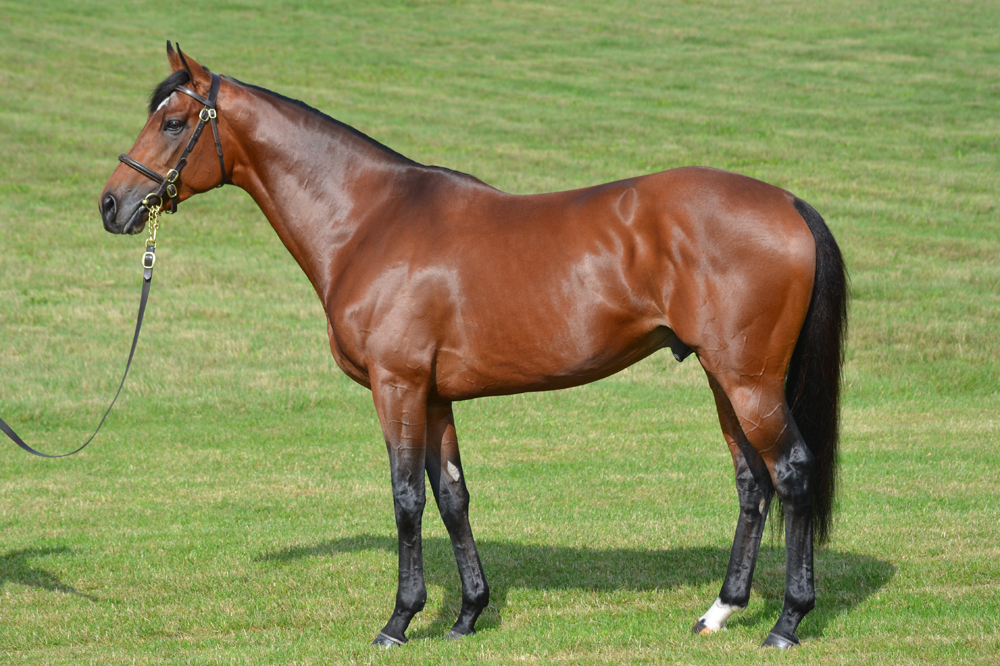Al Kazeem is the second high-profile stallion prospect to be syndicated within the last 12 months. As they did with Nathaniel before him, breeders seized on the opportunity to take equity in Sandringham’s new resident.
No fewer than 100 shares in Al Kazeem were dispersed inside two weeks – and that during the hectic round of yearling sales at Tattersalls in October, which preoccupied most breeders.
There was plainly an appetite to secure annual berths at the court of two top-class racehorses with beguiling pedigree credentials. In Nathaniel’s case, that translated to a first-season book of 148 mares with a fertility rate in excess of 90%.
It’s as firm a foundation as any young stallion could wish for. And Al Kazeem is heading the same way: there are several duplications within the shareholder ranks, both of which read like a Who’s Who of the breeding industry.
Previously commonplace, the syndication of leading stallion prospects has been a rare phenomenon of late. In the pre-Maktoum era stallions were routinely syndicated into 40 shares, which largely represented the size of their annual book of mares.
The process offered breeders the opportunity to share in that stallion’s fortunes. Just as importantly, it guaranteed shareholders annual access to a successful stallion at a time when 40-mare books would not remotely cater for overall demand.
That went west with increased stallion activity. Fertile stallions today breed to four times that number of mares. Breeders have access to all but the elite sires, and with both the Maktoums and Coolmore prepared to underwrite the commercial risk on their own, syndication lapsed.
Its return in the upper echelons of the business has been partially driven by the competition any stallion aspirant faces from the game’s aforementioned behemoths. The latter’s broodmare bands are of sufficient size to support any newcomer but the same is not true of smaller, elite outfits.
“In this day and age you need numbers on your side,” says the Queen’s bloodstock and racing advisor John Warren, who syndicated Al Kazeem, “and the Queen was keen to invite the bloodstock industry to take a part of Al Kazeem.”
We didn’t need to syndicate Al Kazeem but the Queen was keen to make sure breeders could own equity in him
Warren opted for a 100-share syndicate entitling each shareholder to one breeding right annually, whereas Nathaniel was essentially syndicated into 50 shares, each of which came with two breeding rights. Warren had syndicated Motivator along such lines in 2005.
“We decided on the 100-share syndicate because we felt some breeders didn’t need two breeding rights each year,” Warren says. “It was easier that way, and by being less expensive per share it broadened the shareholder base.”
Despite some high-profile additions to the breeding community over the last decade, very few stallion prospects could confidently be syndicated into 100 shares. Yet Al Kazeem, a magnificent physical specimen, sold himself on the back of a stellar racing season.
A winning two-year-old at Newbury, Al Kazeem progressed to exalted heights over four seasons in Roger Charlton’s care, culminating in his triple Group 1 strike, the last two in the Prince of Wales’s and Eclipse Stakes. Both those races were over ten furlongs and Al Kazeem had clock-watchers drooling.
His Royal Ascot defeat of Mukhadram was gained in a time bettered just once in the last 35 renewals of the Prince of Wales’s Stakes. Equally, since 1960, only Sea The Stars has posted a faster winning time in the Eclipse at Sandown, where Al Kazeem routed Declaration Of War.
Those performances ensured that no horse in the world bettered his 124 rating in the ten-furlong turf category on the World Thoroughbred Rankings. Yet performance is only one part of the Al Kazeem equation.
A son of piping-hot sire Dubawi out of a Darshaan mare, Al Kazeem is free of the ubiquitous blood of Sadler’s Wells, Danehill and their respective clans.
“That was a huge help in syndicating him,” Warren admits. “He sits beautifully on a page with those outstanding sires from Northern Dancer’s male line.
“You have to be very selective when syndicating horses at the higher end,” Warren continues. “I’m also guessing that Dubawi will be very hard to get into now. That ticks another box for Al Kazeem.
“As it is, the shares have attracted a diverse selection of breeders with mares that can make a stallion, which is very important. They will support him for three years and hopefully they will end up with a valuable asset.”
The early signs are promising. Barely had the syndication process closed before Sheikh Joaan bin Hamad Al Thani committed three suitors for which he paid $10 million at auction: Nathaniel’s three-parts sister Changing Skies, dual Breeders’ Cup heroine Mizdirection and Grade 1 winner Shotgun Gulch.
Meanwhile, the Warrens’ Highclere Stud has committed Regal Parade and Entifaadha’s dam Model Queen, while the Queen herself is sending Memory, winner of the Queen Mary and Cherry Hinton Stakes. Night Frolic, dam of Bonfire and Joviality, is also booked, as is Ask’s dam Request, together with half-sisters to Dar Re Mi and Attraction.
Al Kazeem’s syndication required breeders to pay £60,000 per share, which values the horse at around £6 million. It is an investment unencumbered by the natural financial ceiling governing stallions with less promising credentials; Dubawi’s £100,000 covering fee for 2014 is ample evidence of that.
One year from now, shareholders will be happy if they can reflect on a collective effort to match Nathaniel’s current status. The son of Galileo was syndicated for £130,000 per share (two annual breeding rights) and covered a book as glittering as it was ample at Newsells Park Stud. The book embraced no fewer than 120 mares of Group or stakes calibre.
“It has been a fantastic year for Nathaniel,” says Newsells Park Stud General Manager Julian Dollar. “The horse has the support of many of Europe’s top breeders and that quality is going to make a massive difference.
“Because Nathaniel is syndicated we already have 70 to 80 mares locked in to his second book, and we are expecting him to attract more quality mares as a result of his first book. The good thing is that people saw the opportunity to be part of something successful. The potential benefits for them are huge.”
Newsells Park is also among the shareholders in Al Kazeem. “He fits our broodmare band,” Dollar says. “You can send most mares to him, and we also feel it is important for Her Majesty to have a stallion like him.”
Asked if that had influenced Newsells’ decision, Dollar replies: “We are trying to run a business here. As much as we all want the Queen to do well, it has to be the right horse. We feel Al Kazeem has a lot going for him.”
It’s hard to dispute the sound mechanics behind syndicating horses of such calibre. A form of collective is at work: ‘smaller’ stallion studs are aligning with the breeding industry’s cream in the hope they can all share the fruits of success.
However, this resonance extends only to the few stallion prospects not already in the hands of the big players. “The horse has to be what they call ‘sexy’, and it must be attractively priced,” Dollar maintains.
“If a breeder isn’t sure, he is unlikely to buy a share. He might use the horse in his first year and then wait and see what happens. If you set the wrong share price the stallion will go cold even before you start.”
A seven-year gap punctuated the syndications of Motivator and Nathaniel. That alone indicates how rarely the opportunity arises, yet for outfits like Newsells and Sandringham, the concept of sharing equity works.
“If you are not a powerhouse you do need to look at the benefits of syndication,” says Peter Stanley, who runs Newmarket’s Stanley House Stud and its sister property New England Stud.
“There is a good case for it but the key is that shares must be attractively priced and you must want to use the horse over the long term.”
Stanley has stood syndicated stallions at Stanley House, among them Vettori and Inchinor, both of which traded profitably for shareholders. He has seen the business change immensely in the last 25 years, but syndication still appeals in specific circumstances.
“As a shareholder, you share both the pain and the gain,” he says. “We took shares in Nathaniel and Al Kazeem partly because we feel there is the chance of a significant upside with both horses.
“Against that, it’s not easy to syndicate a less valuable, less obviously-attractive horse. Having the Maktoum and Juddmonte stallions is an attractive option for breeders and that has meant there is less of a requirement for the corner-shop type of stallion stud.”
The decline in syndication beneath premier-league stallion prospects is lamented by Dena Arstall, who breeds from a handful of mares annually.

Nathaniel covered 148 mares in his first season at Newsells Park Stud
Arstall has seen both sides of the coin: she profited from joining the Namid and Bahamian Bounty syndicates but saw the flip side with Mister Baileys, whose recovery from a near-fatal attack of grass sickness left him with fertility problems.
Owning stallion shares appeals to Arstall, who does not breed for the commercial market. It affords small breeders the chance to exercise their judgement. A successful call on a stallion prospect yields the option of cashing in or guaranteed use of that stallion over his lifetime.
“If I had black-type mares I would undoubtedly have bought a share in Nathaniel,” she says. “It was the same with Motivator when he retired, although in his case I was able to use him twice.”
Arstall’s priority is to maximise the potential in her mares through the racecourse exploits of their progeny. She went to Motivator primarily because she believed in him, but also because the syndicate was replete with successful breeders. Should Motivator’s profile have benefited from such patronage, she could always sell her yearling if she chose.
She did that with yearlings by Bahamian Bounty when that stallion’s stock rose, reaping dividends of 80,000gns and 40,000gns.
“Because I’m not a commercial breeder I often wait to use a stallion in his third or fourth year, when demand can falter,” Arstall continues.
“I don’t think there is enough choice of sire in the £6,000-£10,000 range in Britain. I would like to see more syndication of this type of stallion.
“I believe in the concept of shareholders, but I only ever use a stallion because I like him. Of course it’s very welcome when you make money on a share, as I did when Namid was sold, but from my perspective it’s all about what’s best for my mare.”
Arstall and her ilk have less opportunity in Britain to invest in stallion shares at their level as a result of significantly larger stallion books. Access to such stallions is all but assured, while stallion masters standing them can ‘get out’ financially much quicker than of yore.
So much so, indeed, that the numbers game has become a key facet within the breeding business. It applies right across the board, even to horses like Al Kazeem.
“We didn’t need to syndicate Al Kazeem,” Warren says, “but the Queen was keen to make sure breeders could own equity in him. She was plucky enough to take the plunge and buy the horse, and the feedback I got was that all the shareholders very much wanted to support her initiative.
“They know she represents our industry in such a way that it sends out a really strong message to racing as a whole. It might even help to focus attention on issues like improving prize-money. It can only benefit the sport.”
Motivator stood at Sandringham until his relocation to France this time last year. He remains the property of the original syndicate, which decided he was a more natural fit with the rhythms of racing in France. He also has access to a new pool of breeders in that country, all of which may help him reverse the tide of injuries and bad luck that afflicted his early innings.
Given a smoother early passage through his stallion life, Al Kazeem may yet elevate Sandringham to the heights it last scaled when Shirley Heights was in residence three decades ago. In that event, the 34 other individual shareholders, named on the opening spread, will also be raising a cup.



